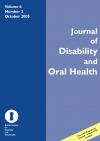Journal of Disability and Oral Health

- Cover Date:
- April 2001
- Print ISSN:
- 1470-8558
- Electronic ISSN:
- 1754-2758
- Vol:
- 2
- Issue:
- 1
Treatment cushions in the dental care of patients with disabilities
To achieve optimal body position in the dentist’s chair the patient’s body should be relaxed and well supported. Joints and muscles should be in the rest position. Many people with disabilities have difficulties in achieving a relaxed body position, for example, patients with different neurological, rheumatic or mental states and impairments. In spastic patients it is vital to break the pathological extension pattern through a body posture that will produce a relaxed muscular tone. Shoulders should be in a forward position and arms softly flexed in front of the body. The chin should be as close to the chest as possible and hips and legs flexed and separated to achieve maximal relaxation (Figure 1). Mun-H-Center in Gothenburg, Sweden, a National R e s o u r c e Centre for orofacial aids, has together with Uri-Form Designs1, developed a set of cushions designed for use during dental care, in order to assist patients to achieve a relaxed body position and facilitate the caregiver’s working conditions. The cushions provide a non-yielding, steady and anatomical support. The filling material inside the inner case of polyester, covered with polyurethane, consists of granules of polystyrene. The outer case is made of 100 per cent cotton, comfortable and pleasant for the body to rest on. For cleaning, the cushion is moistened with water and dried by hand with regular household cleaners. Cleaning with alcohol is possible. The outer case of cotton can be machine-washed at 60oC. For hygienic and practical reasons it is recommended that the cushions be protected close to the face with operating cloths of cotton fabric or similar. TUMLE dental cushions are available in a pack of four (Figures 2 and 3). 1. The crescent is designed to support the neck, with the forward extensions by the ears (Figure 2A). 2. The safeguarder, in the shape of a ring, is put under the patient’s neck and around the shoulders, back and ar ms. The ends of the cushion are fixed together at the level of the patient’s diaphragm by Velcro. The safeguarded cushion has a supportive and relaxing effect on this part of the body (Figure 2B) 3. The leg relaxer should be placed under the hollows of the knees. Legs should be at rest, drawn upwards in a f l e x e d position. This cushion has a leg-separating portion, which should be put between the knees in spastic patients to inhibit the leg extension reflex. In order to fix the cushion at an optimal height under the
1. Uri- Form Designs, Lasal, Industrivej 15, DK-8881 Thorso, Denmark
- Article Price
- £15.00
- Institution Article Price
- £15.00
- Page Start
- 37
- Page End
- 38
- Authors
- Bitte Ahlborg
Articles from this issue
- Title
- Pg. Start
- Pg. End
- UNLOCKING BARRIERS TO CARE - Guidelines for the Oral Management of Oncology Patients Requiring Radiotherapy, Chemotherapy and Bone Marrow Transplantation
- 3
- 14
- Dentist-related barriers to treatment in a group of individuals with Down syndrome in France: implications for dental education
- 18
- 26
- Preventing self-inflicted soft tissue trauma: a case report in an adult with severe neurological impairment
- 27
- 29
